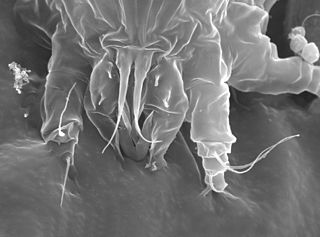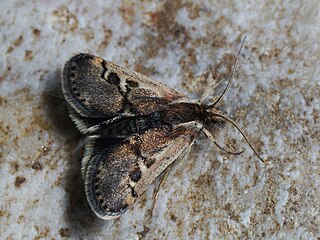Related Research Articles

Lygodium is a genus of about 40 species of ferns, native to tropical regions across the world, with a few temperate species in eastern Asia and eastern North America. It is the sole genus in the family Lygodiaceae in the Pteridophyte Phylogeny Group classification of 2016. Alternatively, the genus may be placed as the only genus in the subfamily Lygodioideae of a more broadly defined family Schizaeaceae, the family placement used in Plants of the World Online as of November 2019.

The Pyraloidea are a moth superfamily containing about 16,000 described species worldwide, and probably at least as many more remain to be described. They are generally fairly small moths, and as such, they have been traditionally associated with the paraphyletic Microlepidoptera.

Lygodium microphyllum is a climbing fern originating in tropical Africa, Southeast Asia, Melanesia and Australia. It is an invasive weed in Florida where it invades open forest and wetland areas. The type specimen was collected in the vicinity of Nabúa, on the island of Luzon in the Philippines by Luis Née.
Neomusotima is a genus of moths of the family Crambidae.

Floracarus perrepae is a species of herbivorous mite belonging to the family Eriophyidae. It is native to Australia (Queensland), China and New Caledonia. As it is known to attack and eat the invasive fern species Lygodium microphyllum, it is being considered for use as a biological pest control agent in Florida.

Hellula undalis, the cabbage webworm or Old World webworm, is a moth of the family Crambidae. It is a widespread species which is found from Europe across Asia to the Pacific. It was first described from Italy.

Parapoynx fluctuosalis or Fluctuating China-mark or Waved China-mark, is a moth of the family Crambidae. It is a widespread species, known from Africa, India, Sri Lanka, China, Japan, Malaysia, Taiwan, Guam, Hawaii, Fiji, Australia and the Galápagos Islands. It is also an introduced species in Europe, where it has been recorded from Great Britain, the Iberian Peninsula and Sardinia.

Austromusotima camptozonale, the climbing maidhair pyralid moth, is a moth of the family Crambidae. It is native to Australia, but attempts have been made to introduce it to southern Florida as a biological control agent for Old World climbing fern.
Siamusotima is a genus of moths of the family Crambidae. The genus was erected by Maria Alma Solis et al. in 2005.

Glyphodes microta is a moth of the family Crambidae. It is found in Australia, where it ranges from the east coast to the west coast across the middle of the continent.
Austromusotima metastictalis is a moth of the family Crambidae. It is found in New Guinea and possibly also in northern Queensland in Australia.

Titanio normalis is a species of moth in the family Crambidae. It is found in Spain, Italy, Austria, the Czech Republic, Slovakia, Hungary, Croatia, Romania, Bulgaria, the Republic of Macedonia, Greece, Belarus, Russia and Turkey.

Herpetogramma basalis is a species of moth in the family Crambidae. It is found on the Canary Islands and in Japan, China, Australia, Sri Lanka, India, Indonesia, La Réunion, South Africa, and Mali.
Margarosticha repetitalis is a moth in the family Crambidae. It was described by Warren in 1896. It is found in Australia, where it has been recorded from Queensland and Western Australia.
Theila siennata is a moth in the family Crambidae. It was described by Warren in 1896. It is found in Australia, where it has been recorded from Queensland.
Lygomusotima constricta is a moth in the family Crambidae. It was described by Maria Alma Solis and Shen-Horn Yen in 2004. It is found in the Philippines (Luzon).
Lygomusotima stria is a moth in the family Crambidae. It was described by Maria Alma Solis and Shen-Horn Yen in 2004. It is found from Singapore and Thailand to Pulo Laut.

Neomusotima fuscolinealis is a moth in the family Crambidae. It was described by Yoshiyasu in 1985. It is found in Japan and Hong Kong. The species was studies as a potential biological control agent for Lygodium japonicum in the United States, but the species was deemed unsuitable since it also fed on the native species Lygodium palmatum.
Agrioglypta excelsalis is a moth in the family Crambidae described by Francis Walker in 1866. It is found on Sulawesi, Lifou Island, as well as in Bhutan, Thailand, Sumatra, Papua New Guinea, Samoa and in Australia, where it has been Western Australia, Queensland and northern New South Wales.
Archernis mitis is a moth in the family Crambidae. It was described by Turner in 1937. It is found in Taiwan and Australia, where it has been recorded Queensland and New South Wales.
References
- ↑ "global Pyraloidea database". Globiz.pyraloidea.org. Archived from the original on 2011-02-26. Retrieved 2014-07-15.
- ↑ Solis, M. Alma; Yen, Shen-Horn & Goolsby, John H. (2004). "Species of Lygomusotima new genus and Neomusotima Yoshiyasu (Lepidoptera: Crambidae) from Australia and Southeastern Asia feeding on Lygodium microphyllum (Schizaeaceae)". Annals of the Entomological Society of America. 97 (1): 64–76. doi: 10.1603/0013-8746(2004)097[0064:SOLNGA]2.0.CO;2 .